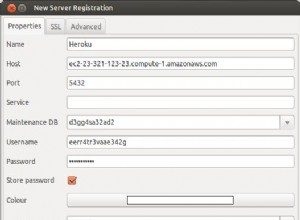Tak właśnie zrobiłem.
Ponownie wykorzystałem nieużywane pole w patient tabela do oznaczenia nieduplikowanych (N), pierwszego zduplikowanego (X) i innych zduplikowanych pacjentów (Y). Możesz również dodać do tego kolumnę (i upuścić ją po użyciu).
Oto kroki, które wykonałem, aby wyczyścić moją bazę danych:
/*1: List duplicated */
select pk,pat_id, t.`pat_id_issuer`, t.`pat_name`, t.pat_custom1
from patient t
where pat_id in (
select pat_id from (
select pat_id, count(*)
from patient
group by 1
having count(*)>1
) xxx);
/*2: Delete orphan patients */
delete from patient where pk not in (select patient_fk from study);
/*3: Reset flag for duplicated (or not) patients*/
update patient t set t.`pat_custom1`='N';
/*4: Mark all duplicated */
update patient t set t.`pat_custom1`='Y'
where pat_id in (
select pat_id from (
select pat_id, count(*)
from patient
group by 1
having count(*)>1
) xxx) ;
/*5: Unmark the 1st of the duplicated*/
update patient t
join (select pk from (
select min(pk) as pk, pat_id from patient
where pat_custom1='Y'
group by pat_id
) xxx ) x
on (x.pk=t.pk)
set t.`pat_custom1`='X'
where pat_custom1='Y'
;
/*6: Verify update is correct*/
select pk, pat_id,pat_custom1
from `patient`
where pat_custom1!='N'
order by pat_id, pat_custom1;
/*7: Verify studies linked to duplicated patient */
select p.* from study s
join patient p on (p.pk=s.patient_fk)
where p.pat_custom1='Y';
/*8: Relink duplicated patients */
update study s
join patient p on (p.pk=s.patient_fk)
set patient_fk = (select pk from patient pp
where pp.pat_id=p.pat_id and pp.pat_custom1='X')
where p.pat_custom1='Y';
/*9: Delete newly orphan patients */
delete from patient where pk not in (select patient_fk from study);
/* 10: reset flag */
update patient t set t.`pat_custom1`=null;
/* 11: Commit changes */
commit;
Z pewnością istnieje krótsza droga, z jakimś sprytniejszym (skomplikowanym?) SQL, ale osobiście wolę prosty sposób. Pozwala mi to również sprawdzić, czy każdy krok robi to, czego oczekuję.




